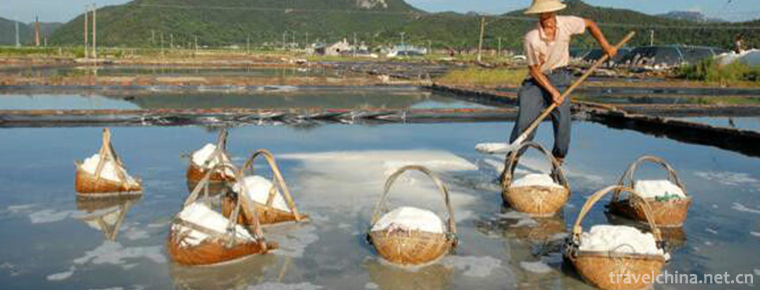Salt drying Techniques
Salt drying Techniques
Salt-drying process is a special kind of handicraft technology. Its existing form is different from the general intangible culture. Its products are closely related to people's daily life and industrial production. It uses sea water as its basic material, and uses beach and saline mud (or artificial doped lime soil), combined with solar and wind evaporation, through manual work such as sprinkling, sprinkling, etc., to make brine, and then through natural crystallization such as frying or sunshine, wind energy, etc., to form original salt. There are more than 10 steps in the whole process, which are operated by hand, but contain abundant scientific and technological genes. It is a intangible cultural heritage of historical and cultural value.
In 2009, the Millennium Ancient Salt Field was listed as a cultural relic protection unit in Tibet Autonomous Region, and its well salt drying skills were listed in the second batch of national intangible cultural heritage list.
There are disputes over the declaration of this skill in many places.
Salt-drying process is a special kind of handicraft technology. Its existing form is different from the general intangible culture. Its products are closely related to people's daily life and industrial production. It uses sea water as its basic material, and uses beach and saline mud (or artificial doped lime soil), combined with solar and wind evaporation, through manual work such as sprinkling, sprinkling, etc., to make brine, and then through natural crystallization such as frying or sunshine, wind energy, etc., to form original salt. There are more than 10 steps in the whole process, which are operated by hand, but contain abundant scientific and technological genes. It is a intangible cultural heritage of historical and cultural value.


-
2.Jiulian mountain
Jiulianshan Scenic Spot is located in Songshuping Village, Shangbali Town, Huixian City, Xinxiang City, Henan Province. It belongs to the south foot of Taihang Mountain
Time 2018-12-22 -
3.Yuan Dynasty Capital City Wall Site Park Yuandadou Chengyuan Site Park
The Yuandu Chengyuan Site Park was built on the Tucheng Site of Yuandu (National Key Cultural Relics Protection Unit, batch No. VI-1). It is located near Mingguang Village, Southern College Road
Time 2018-12-23 -
4.Baishuizhai Scenic Area
Baishuizhai Scenic Spot is located in Paitan Town, Zengcheng District, with an area of about 170 meters. The Tropic of Cancer passes through it. It is known as the magnificent Emerald on the Tropic
Time 2019-01-02 -
5.jianchuan museum cluster
Jianchuan Museum is called Jianchuan Museum Settlement in Chengdu City. Founded by private entrepreneur Fan Jianchuan, it is located in Anren Town, Dayi County, a small museum town of China
Time 2019-01-21 -
6.Jinxi ancient town
Jinxi Ancient Town is located in the southwest of Kunshan City, Jiangsu Province. It is 100 kilometers from Shanghai Pudong International Airport and 75 kilometers from Wuxi Airport.
Time 2019-01-29 -
7.Tujia Style Garden
Zhangjiajie Tujia Style Park is located in Zhangjiajie City, a beautiful pearl. The Park covers an area of more than 80 mu with a total investment of 75 million yuan. It is a large-scale
Time 2019-02-22 -
8.Production Techniques of Tibetan Mineral Plant Pigments
Since the emergence of human beings, mineral pigments have been accompanied by human beings. Mineral pigments were first used to draw murals
Time 2019-04-09 -
9.Guilin fishing drum
Guilin fishing drum, commonly known as sentiment, is the local traditional rap and singing art of Guilin. The Song Dynasty was introduced into Guilin from the north,
Time 2019-05-02 -
10.Huangzhong embroidery
Huangzhong heap embroidery is a kind of art that uses the techniques of "shearing" and "heap" to create images. It is mostly used in Tangka production, with Tibetan Buddhist themes
Time 2019-05-04 -
11.Brow tune
Meihu Opera is a local traditional drama in Shaanxi Province. From the development of the floor stall rap and social fire, the floor stall and social fire performances always focus on singing. Its act
Time 2019-06-01 -
12.University of International Relations
University of International Relations (University of International Relations), referred to as "Guo Guan", is located in the western suburb of Beijing. Ministry of Education of the People's R
Time 2019-09-22